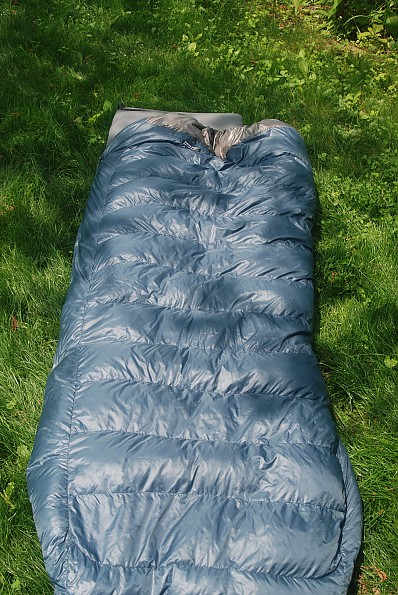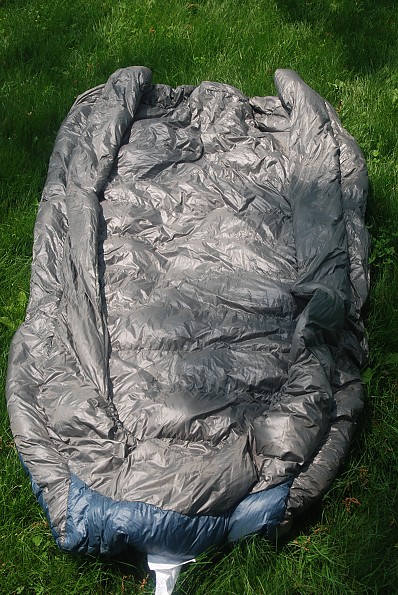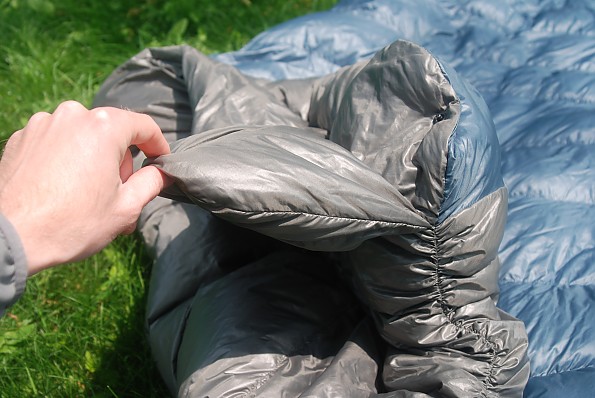
Therm-a-Rest sleep system.
Therm-a-Rest sleep systems include various combinations of insulation, pads, and pillows for different temperatures, climates, and activities. By combining different products, it's possible to tailor the (more or less) ideal sleep system for the activity of your choice.
I tested a Therm-a-Rest sleep system that combined the following products:
-
NeoAir All Season pad (2011 prototype, Regular size)
-
Alpine Down Blanket (35°F/2°C, Regular size)
-
Fitted Sheet (Regular size)
The total sleep system is wonderfully flexible for different uses and is especially well suited to cooler weather. It's very comfortable, but I paid the price in weight and minor inconvenience.
At 3 pounds 6.3 ounces, the total system is heavier than my usual combination of a synthetic EMS Velocity 35 sleeping bag and a cut-in-half Therm-a-Rest RidgeRest closed-cell foam pad. Additionally, the NeoAir is a real challenge to inflate.
This sleep system is best for camping and weekend backpacking trips in hot weather, and longer backpacking trips in colder weather. As the weather cools, or your tolerance for sleeping on hard surfaces decreases, the increased insulating capacity and comfort this pad supplies outweigh the minor penalties in weight and challenging setup.
Pros
-
luxuriously comfortable
-
warm
-
compact
-
anti-slide straps work!
Cons
-
NeoAir All Season pad is difficult to inflate
-
system is a bit heavy
-
Fitted Sheet is heavy and doesn't add warmth
-
blanket snap system is clumsy
-
blanket system makes snuggling difficult
Best For:
This Therm-a-Rest sleep system is best for camping and weekend backpacking trips in hot weather, and longer backpacking trips in colder weather. As the weather cools, or your tolerance for sleeping on hard surfaces decreases, the increased insulating capacity and comfort this pad supplies outweigh the minor penalties in weight and challenging setup.
Setup
Setting up the Therm-a-Rest sleep system requires inflating the NeoAir All Season pad and affixing the Fitted Sheet and Alpine Down Blanket. I learned to shorten the setup by leaving the fitted sheet on the pad when storing it in my pack.
The NeoAir All Season pad is lung busting to inflate without a pump. I have massive lung capacity, but inflating the pad required 20 lung fulls, and often ended in me seeing stars and sitting down! If getting a little hypoxia bothers you, and you're willing to carry a few more ounces, I would recommend the forthcoming NeoAir Pump Sack. I'd probably still forgo the pump, to save weight; that's just me though.
(For January 2012, Therm-a-Rest will offer a NeoAir Pump Sack, a stuff sack that lets you fill a NeoAir pad with two bags of air, and then converts into a camp seat, stuff sack, or pack liner. The new-for-fall 2011 NeoAir AirTap Pump Kit works similarly, using a plastic bag)
Affixing the sheet is a challenge, as the full length of the pad needs to be passed through a series of grippy, rubberized straps. A small, toughened port in the sheet allows the pad's inflation valve through, but isn't quite large enough.
Once the sheet is affixed, the down blanket attaches to small plastic snaps around the perimeter of the sheet. The snaps are small, and it was difficult to snap them securely with cold fingers. Further, vigorous movement can unsnap them easily.

Bottom view of system, showing anti-slide straps and snaps.
Comfort/Warmth
NeoAir All Season Pad
This system is incredibly comfortable once setup. In a month of testing, including three nights camping, four nights backpacking, and two weeks of home/backyard use, I always slept soundly. The NeoAir All Season pad is thick enough (approximately 2.5 inches) to permit sleeping on my side, back, or stomach.
This pad was warm! Despite nights that dipped down to 36 degrees Fahrenheit, this system kept me warm. The pad itself, which has a 4.9 R-value, seemed to radiate heat. This may be an effect of the metallic foil of each of the pad's internal baffles reflecting my bodily heat back to me. (I'll update after I continue to test the NeoAir All Season this winter.)
The pad is approximately 79 inches long, which is a bit long for me (I'm 5' 8"). This didn't present serious problems, but in combination with the Down Blanket, it required me to position myself with my feet at the bottom of the pad, with approximately 11 inches of pad above my head. If this was a closed-cell foam pad, I would have rolled that excess to create a pillow, but when the NeoAir All Season is firmly inflated, it can't easily be doubled.

Alpine Down Blanket, bottom view.
Alpine Down Blanket
I tested the Alpine Down Blanket as part of the sleep system. The blanket and pad both kept me warm in temperatures right at the edge of the blanket's rated capacity of 35°F. (The NeoAir All Season pad has a 4.9 R-value.)
Despite the draft collars running the length of the down blanket, drafts still snuck in however. Snapping the blanket to the sheet seemed to make the problem worse. Additionally, when I rolled over, the snaps would often pop off.
After some trial and error, I left the bottom of the quilt snapped to the pad, and unsnapped the top several snaps. With the upper half of the quilt loose, I could wrap it around myself, increasing warmth and decreasing drafts.
I seldom use down insulation for most of my hikes in Maine, because frequent rain and high humidity make it prone to lose loft. However, this blanket, filled with 700-fill down, retained loft well, despite cold, rainy weather, and moderate humidity.
The shell of the quilt shed a few droplets of condensation that formed in my tent on several occasion, but absorbed water quickly when I accidentally dipped the foot box area in a small puddle that formed at the base of my tent. Because the shell isn't very water resistant, I wouldn't recommend this blanket for very humid, rainy environments.

Alpine Down Blanket, showing draft collar.
Fitted Sheet
The main function of the Fitted Sheet is to bind the Down Blanket to the NeoAir pad. The sheet added a degree of comfort, but wasn't so luxurious that I would bother bringing it, if not for the functional purpose it served.
Weight conscious hikers will probably want to forgo this 6.4-ounce part of the system and instead opt for the Fast & Light Mattress Snap Kit that also serves this purpose, but weighs just 0.6 ounces (17 g). For car camping, sleepovers, or base camp use, the Fitted Sheet might be worth its weight (6.4 oz), but it's not worth the weight for backpacking for me.
One positive feature was the anti-slide straps on the bottom of the sheet. These straps hold the sheet over the pad, but are rubberized, and prevent the whole system from sliding around on the slick floor of a tent. Since the floor of my shelter is siliconized nylon, this feature was a pleasure!
Sleep system, showing anti-slide pads.
Durability
NeoAir All Season Pad
Therm-a-Rest supplied me with an optional Universal Repair Kit (.6 oz / 16 g). Despite camping on rough surfaces (including gravel), the pad never punctured. I never used the repair kit, but it's similar to a bicycle tire repair kit, and I have no reason to think it wouldn't be effective.
Alpine Down Blanket
Despite frequent packing and unpacking, the Down Blanket proved durable. The seams still look tight, and the shell fabric didn't tear, and hasn't pilled at all after seven nights out, and 14 days of additional "bag time" around the house and yard.
The blanket lost several feathers along the seams, but no more than five to 10.
Fitted Sheet
The Fitted Sheet showed no signs of wear at all during the test.
Storage
The entire sleep system takes a bit longer to pack up then I like. After a cup of coffee, the system takes nearly three minutes to pack up.
Deflating the NeoAir All Season pad is a bit slow, and removing the Fitted Sheet is clumsy because of the rubberized straps on the bottom. To save time, I tried deflating the pad with the sheet on. This is faster than removing it, but increases the bulk of the deflated system considerably. If you're short on time, try leaving the sheet on. If you're short on space, remove the sheet and pack it separately.
The NeoAir pad rolls up fairly small, and can even be fitted into a frame-less pack as a supplemental frame! The down blanket compacts easily, and lofts quickly after unpacking.
Summary
The combination of the NeoAir All Season Pad, Fitted Sheet, and Alpine Down Blanket makes for a versatile, warm, comfortable sleep system. As configured at 3 pounds 6.3 ounces, it's a bit heavy for my backpacking style, but for this small penalty in weight, you get a very flexible, comfortable system.
I'm going to continue to use this system together for my winter hikes and bike trips. Alone, the down blanket is slowly replacing my synthetic bag. I'm also going to be experimenting with using the down blanket as an "enhancer" in an attempt to create a deep winter sleep system in conjunction with a light synthetic bag.
I would recommend Therm-a-Rest's NeoAir All Season Pad, Alpine Down Blanket, and Fitted Sheet highly as a general purpose sleeping system for shorter trips. Together with a closed-cell pad, an all-season adventurer would need no additional pad. For ultra-light trips, a closed-cell foam pad would suffice. For more comfort, the NeoAir would be ideal. For deep winter trips, both pads could be combined for ultimate warmth.

Seth atop Maine's Deasey Mountain on the International Appalachian Trail, with hiking buddy Steve.
Testing Circumstances
I tested the NeoAir All Season pad for approximately 60 days in spring and summer. During this period, I tested the pad:
- While camping for three nights in northern Maine. The elevation was only slightly above sea level. Temperatures ranged from a low of approximately 36°F overnight, to a high of approximately 43°F overnight.
- While on a four-day backpacking trip north of Maine's Baxter State Park. I traveled approximately 12 miles per day, bushwhacking and often fording rivers. Weather was cool, humid and rainy, with the last day warmer and sunnier. Nighttime temperatures went as low as approximately 46°F. Day time temperatures were between 56° and 70°F.
- As my primary sleeping pad for 14 days in my home, on a hardwood floor.

Seth's pack on the International Appalachian Trail in Maine.
NeoAir All Season Pad
Claimed Weight: 14 oz / 410 g
Tested Weight: 1 lb 3.2 oz / 544 g
Note: I tested a 2011 prototype, with a slightly non-standard weight and size.
Alpine Down Blanket
Claimed Weight: 1 lb 5 oz / 624 g
Tested Weight: 1 lb 7.3 oz / 662 g
Fitted Sheet
Claimed Weight: 6.5 oz / 181 g
Tested Weight: 7.8 oz / 220 g

 by Seth Levy
by Seth Levy









